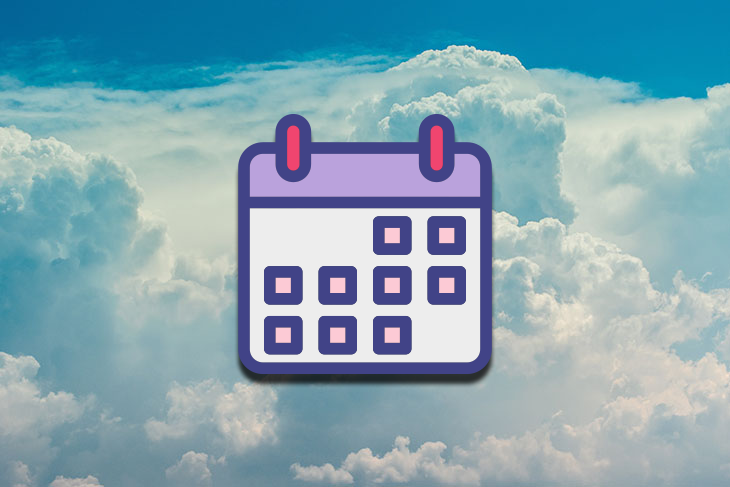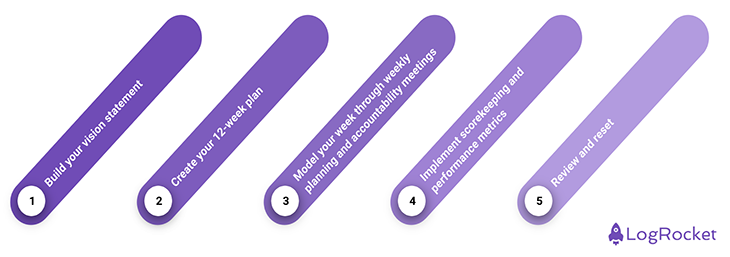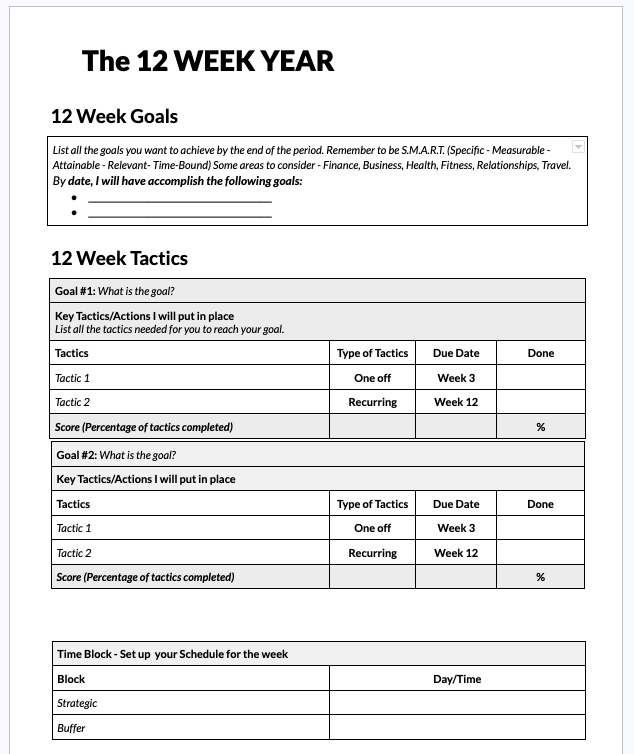Isn’t it frustrating when you’ve worked hard toward your goals yet see no progress? That was my experience a few years ago when I was trying to level up my productivity while pushing to reach my personal and professional goals.

It wasn’t about how hard I was working, but about how efficiently I was working. My frustration wasn’t with setting goals, but realizing that I was falling short when I assessed my progress.
I explored various productivity techniques, from reading books like Cal Newport’s Deep Work to employing the Pomodoro Technique. My journey led me to a transformative book — The 12 Week Year.
In this article, we’ll talk about what the 12 Week Year is, how it works, and how you can implement it to better your goal setting and execution.
As I mentioned, the 12 Week Year idea actually comes from a book written by Brian Moran and Michael Lennington.
In the book, Brian Moran argues that the problem with the traditional yearly goal-setting system is that it allows people to procrastinate. People wait until the end of the year to realize how far off track they are. Upon this realization, people who want to reach their quotas or sales targets scramble and start making last-minute efforts, often without success.
Have you ever wondered why you see so many end-of-quarter deals? People are scrambling to hit their targets, and you benefit from their urgency. People have targets to meet and get discounts because they’re eager to achieve their goals.
Imagine now a novel approach to work: the 12 Week Year framework offers a structured, time-bound approach to setting and achieving goals.
The proposed method shortens the time frame to accomplish your goals, putting tactics and a scoring system in place to monitor each goal’s progress.
Brian’s system encourages immediate action, ongoing metrics, continuous measurement, accountability for all activities, sustaining focus, and review sessions to evaluate performance.
So, where does the inspiration for the 12 Week Year System come from?
The book’s core idea is simple: shorter, manageable timeframes.
When this book was published, other popular systems were also gaining traction.
The book draws inspiration from various fields:
Those methods are spread across the world and used by millions. Brian Moran and Michael Lennington stand out by integrating these practices into a system applicable to organizations and individuals for professional and personal life.
Though primarily sales-oriented, the system and accompanying training apply to other domains, such as healthcare and financial services. The focus remains the same — improving outcomes.
At its core, the book’s philosophy links to Parkinson’s Law:
Both Parkinson’s Law and the 12 Week Year concept tackle the intricate relationship between time and productivity but from different angles.
We can’t expand time. Yet, we can try to control it. Going faster only comes with specific characteristics.
One of them is the notion of constraint. In this case, Brian Moran creates a new constraint by adding a sense of urgency.
How does it work, and how can you put it in place?
As explained, Brian Moran points out a crucial flaw in setting up goals: “Business will make plans that are due for the end of the year with no robust tracking system.”
You could be planning for a whole year, but if you put suitable activities in place, measuring progress and doing the work regularly, you are setting yourself up for success. This is how the 12 Week Year flips the script entirely.
The system is a well-oiled machine with five components: vision, working from a plan, process control, scorekeeping, and time use.
There is also nothing new under the sun, as it takes back prioritization tactics such as focusing on the two or three activities that are the biggest needle movers.
A big part of the book is accountability, honesty, and transparency concerning work. Two particular chapters, one on “confronting the truth” and the second one on “accountability as ownership,” highlight the importance of being honest with yourself week after week in the progress you are making.
Your actions align with a new mindset, as a year is not 52 weeks anymore. It is 12 weeks.
A month becomes a week. A week becomes a day. You can get four times the work output per year by compressing down what a year is.
It also means for your organization that the traditional year is gone. Each 12-week cycle stands alone.
The 12 Week Year book provides various tools and techniques to set you up for success in achieving your goals.
Here are some of the essential tools:
This toolkit aims to guide you in making the most out of your time and effort. It supports the process we are going to review below.
Here are five steps to follow to put in place a 12 Week Year system:

A vision statement is your aim and guide for the 12-week plan.
There are three steps to build your vision statement:
The three steps help you clarify what you’re working towards long-term and ensure that the short-term goals align with the vision.
Break down your vision into actionable goals you can accomplish in 12 weeks.
These should be specific, measurable, achievable, relevant, and time-bound (SMART).
The 12-week plan must contain your tactics for each goal. The tactics are short-term and action-oriented, laying out the tasks required to achieve each 12-week goal.
It’s important to remember the lag and lead indicators for this step.
Plan the weekly execution of tasks to stay on track for your 12-week goals.
Allocate specific blocks of time to particular tasks (strategic and buffer blocks). Make appointments with yourself and treat these blocks as non-negotiable.
Schedule weekly accountability sessions with a peer or by yourself. Review your performance metrics and make necessary adjustments.
Keep a scorecard to track your actions and outcomes.
The scorecard helps in measuring your effectiveness and areas that need improvement. It might include efficiency ratios, financials, or engagement ones.
It’s essential to look at it from the perspective of your lag and lead indicators. Following the performance indicators, you will know which actions to put in place to stay on track for your goals.
At the end of the 12 weeks, stopping and regrouping is vital.
Review your outcomes at the end of the 12 weeks, analyze what worked and what didn’t, and begin the process anew for the next 12 weeks.
There are three views for this last part: the 12 Week Year process review, the performance review and a review of your life balance.
So the big question is, what do you do with these goals once you understand how the 12 Week Year works?
Generally, you need to set up a plan and to set it, you must establish tactics.
It would be best to remember the difference between lag and lead indicators. A lag indicator is an outcome you can’t directly impact. It reflects the result of your actions.
Take, for example, an OKR from your company based on revenue: “increase revenue by 15 percent” or “gain 1,000 new customers”.
Let’s say your team focuses on increasing retention rate. Engaged users offer two results:
This will be your lag indicator.
Conversely, a lead indicator is an immediate metric you can control.
So, what actions can you take that have a direct impact?
Using analytics or reviewing them is neither a lead indicator nor a real tactic because it only tells you a little.
A more actionable approach could be to spend two hours a week reviewing user session recordings alone or as a team. By “sessions,” I mean the recorded experiences of users interacting with your app.
Reviewing these sessions allows you to identify trouble spots where users struggle, offering insights on where to improve your product.
In essence, this can become your lead indicator. Improvements here will lead to better user engagement and retention and increased revenue.
So, you can see how the tactics you put in place can directly impact your goals. You can schedule these weekly tasks for yourself or your team to review and adapt as necessary.
For many people, having a template or visual aid helps increase their productivity. It’s often easier when it’s laid out in front of you, as opposed to having a few different documents or trying to keep things in your head.
For that reason, I created a free 12 Week Year template that’s accessible to download through Google Docs. Click File > Make a copy to download it for your own use and customize it as needed:

The 12 Week Year system is a complete approach and a game changer regarding productivity. It offers a step-by-step tested process supported by tools and documentation.
By adding this approach, whether for personal or professional purposes, you can change the outcomes of your process as fast as in three months.
All documentation to help you set up your 12 Week plan is available on their website.
Featured image source: IconScout
LogRocket identifies friction points in the user experience so you can make informed decisions about product and design changes that must happen to hit your goals.
With LogRocket, you can understand the scope of the issues affecting your product and prioritize the changes that need to be made. LogRocket simplifies workflows by allowing Engineering, Product, UX, and Design teams to work from the same data as you, eliminating any confusion about what needs to be done.
Get your teams on the same page — try LogRocket today.

Chrissie Lamond, VP of Product at Mansueto Ventures, talks about how she builds product experiences across audience segments.

AI governance is now a product feature. Learn how to embed trust, transparency, and compliance into your build cycles.

Rachel Bentley shares the importance of companies remaining transparent about reviews and where they’re sourced from to foster user trust.

Michal Ochnicki talks about the importance of ensuring that the ecommerce side of a business is complementary to the whole organization.